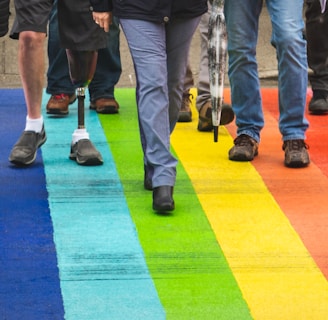How to Foster Inclusivity and Intersectionality for Our Children's Well-being
RESOURCES


In today's diverse and interconnected world, it is crucial for us to cultivate an inclusive and intersectional mindset. By embracing these values, we can provide our children with the support and understanding they need to thrive. In this blog post, we will explore the importance of inclusivity and intersectionality and discuss practical ways to incorporate these principles into our daily lives.
The Meaning of Inclusivity and Intersectionality
Inclusivity refers to creating an environment where everyone feels valued, respected, and included, regardless of their race, gender, sexual orientation, disability, or any other characteristic. It means actively seeking out and embracing diversity, rather than merely tolerating it.
Intersectionality, on the other hand, recognizes that individuals have multiple social identities that intersect and influence their experiences. It acknowledges that a person's experience of discrimination or privilege is shaped by the intersection of various aspects of their identity, such as race, gender, class, and more.
By understanding and embracing both inclusivity and intersectionality, we can ensure that we are not only accepting of others but also actively working to dismantle systemic barriers and create a more equitable society.
The Benefits of Inclusivity and Intersectionality for Children
Children are incredibly perceptive and absorb information from their surroundings. When they grow up in an inclusive and intersectional environment, they learn to appreciate diversity, develop empathy, and become more open-minded individuals.
Here are some key benefits of fostering inclusivity and intersectionality for our children:
1. Empathy and Understanding
By exposing children to a wide range of perspectives and experiences, we help them develop empathy and understanding towards others. They learn to recognize and appreciate the unique qualities and strengths that each individual brings to the table.
2. Reduced Prejudice and Bias
When children are raised in an inclusive and intersectional environment, they are less likely to harbor prejudice and bias towards others. They learn to question stereotypes and recognize the inherent worth of every individual, regardless of their background.
3. Enhanced Problem-Solving Skills
An inclusive and intersectional upbringing encourages children to think critically and find creative solutions to complex problems. By considering multiple perspectives and experiences, they become better equipped to tackle challenges in their personal and professional lives.
4. Increased Resilience
Children who grow up in an inclusive and intersectional environment develop a sense of resilience and adaptability. They learn to navigate diverse social settings, appreciate different cultural norms, and adapt to changing circumstances.
Practical Ways to Foster Inclusivity and Intersectionality
Now that we understand the importance of inclusivity and intersectionality for our children's well-being, let's explore some practical ways to incorporate these principles into our daily lives:
1. Educate Ourselves
Start by educating ourselves about different cultures, identities, and social issues. Read books, watch documentaries, and engage in conversations with people from diverse backgrounds. The more we learn, the better equipped we are to challenge our own biases and assumptions.
2. Encourage Open Dialogue
Create a safe and open space for discussions within our families and communities. Encourage children to ask questions, share their thoughts, and express their opinions. By fostering open dialogue, we can address misconceptions, break down stereotypes, and promote understanding.
3. Celebrate Diversity
Embrace and celebrate the diversity around us. Attend cultural events, explore different cuisines, and learn about various traditions. By exposing our children to diverse experiences, we help them appreciate the beauty of different cultures and backgrounds.
4. Challenge Stereotypes
Teach children to question stereotypes and challenge societal norms. Encourage them to critically analyze media representations and recognize the harmful impact of stereotypes. By doing so, we empower them to become agents of change and advocate for a more inclusive society.
5. Support Inclusive Organizations
Get involved with organizations that promote inclusivity and intersectionality. Support initiatives that aim to create equal opportunities for all individuals, regardless of their background. By actively participating in such efforts, we demonstrate our commitment to building a more equitable society.
6. Lead by Example
Our actions speak louder than words. Model inclusive behavior in our everyday lives. Treat others with respect, listen actively, and stand up against discrimination. By leading by example, we teach our children the importance of inclusivity and intersectionality.
Conclusion
Inclusivity and intersectionality are not mere buzzwords but essential principles that shape the well-being of our children and society as a whole. By fostering inclusivity and intersectionality, we create a nurturing environment where our children can thrive, grow, and contribute positively to the world. Let us commit ourselves to learning, unlearning, and actively practicing these principles, so that we can create a better future for our children.
